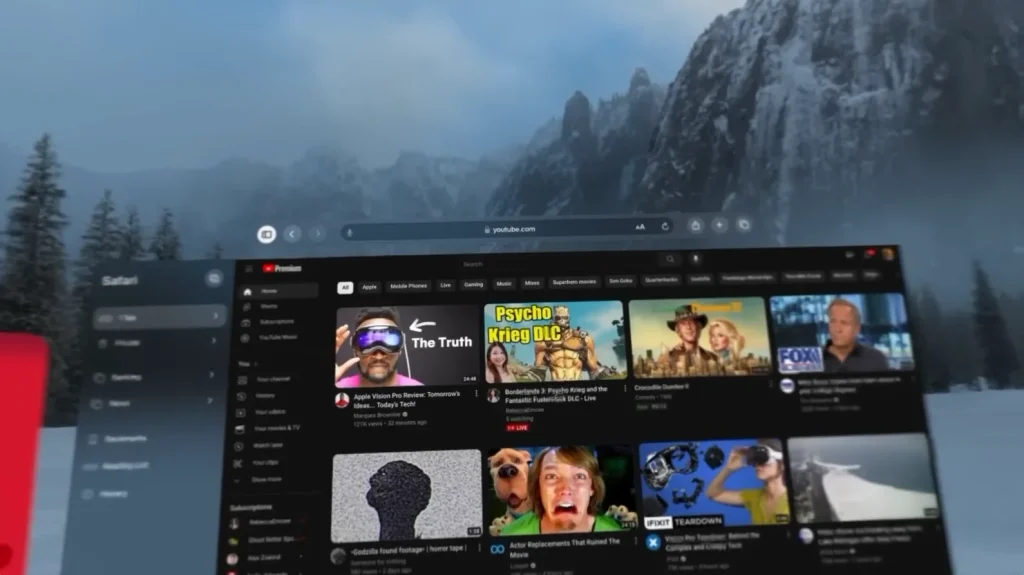Before acquiring the Apple Vision Pro, I never thought it could replace my 65-inch Samsung S95B OLED TV from 2022. However, I must honestly say that after purchasing, I was pleasantly surprised at how well the Vision Pro could compete with modern TVs, prompting me to share my thoughts on this matchup.
Just as in any debate about whether one product can replace another, the answer is not unequivocal, so it is here. Starting off, the Vision Pro was an excellent product, especially regarding the media aspect. I’ll start with a small dose of specifics – the Vision Pro boasts two micro-OLED displays that project 23 million pixels together. Each display has a resolution of 3660×3200 pixels over an area of less than one square inch.
But when we step back into reality, we realize that we don’t watch movies on the Vision Pro up close; we usually push the window back, and here’s where it gets interesting. A certain way to assess quality is by pixels per degree (PPD) — the number of horizontal pixels per degree of viewing angle, indicating the headset’s resolution clarity. The higher the PPD number, the finer the detail display and the clearer the screen appears to the user. The Vision Pro’s PPD, at an average viewing window, is about 34 pixels per degree, lower than the 95 pixels per degree you might see on a standard 65-inch 4K TV from 6.5 feet away.

However, these numbers aren’t very indicative since we can constantly adjust the distance from the window in Vision Pro. Are the Vision Pro’s metrics bad? Definitely not, as if we forget about the numbers, based on personal experience, the visual difference is almost unnoticeable.
Where Apple Vision Pro is good
Where the Vision Pro truly shines is in the simplicity of its operating system. Of course, the OS on modern TVs has significantly improved since, say, 2016, when my Samsung TV would navigate menu items with the speed of a crippled turtle. But even now, the same Tizen OS on the latest Samsung TVs or WebOS on LG TVs doesn’t exactly dazzle with speed and convenience. In contrast, the Vision Pro offers very fast and easy navigation through streaming services and instant connection to headphones, and overall, its use feels much snappier.
Another area where I can identify Vision Pro as an unequivocal leader is in simultaneous viewing in two windows. It’s incredibly convenient to watch two football matches simultaneously, unlike the split screen on a TV, where you can hardly see anything clearly. Also, I recall how quickly and easily my AirPods connect to the Vision Pro; unfortunately, such convenient connectivity, I think, won’t be seen on our TVs any time soon.

Portability is the clear leader here
Portability is arguably Vision Pro’s strongest point. Yes, I can take it on trips, watch movies and other content in a hotel room, etc., which is cool and something my TV cannot do. But that’s about it. I might seem old-fashioned, but I watch movies on my iPad Pro just as successfully, connect headphones, and enjoy the film. Yes, the Vision Pro undoubtedly provides a much better experience, but strangely enough, I don’t need more when traveling.
Why Vision Pro can’t replace a TV
The answer to this question is quite simple, and no, it’s not because the TV has better quality or because it’s more comfortable and doesn’t press on your head. It’s more about the fact that the Vision Pro doesn’t allow for socialization; you can’t watch movies with your family and interact with them fully. It’s an entirely different feeling and emotion when you can hug your significant other, see their face usually, and kiss them. Unfortunately, the Vision Pro limits this. Moreover, even if some form of simplified simultaneous movie watching becomes available in the future, cost becomes a factor, and I highly doubt you’d want to spend on a Vision Pro for each family member.
A minor issue with services
Honestly, there’s too much fuss about this online. Yes, Vision Pro doesn’t have Netflix and YouTube. From what I know, YouTube is developing its app, so it’s only a matter of time. Still, with Netflix, it’s a different story – probably a matter of principle, causing Netflix deliberately not to enter the still small, 500,000-strong Apple Vision Pro market. Is this critical? Obviously not, as you can always open Netflix in a browser and watch the entire movie library, albeit not in 4K, but only in Full HD.

Vision Pro also supports many other services, such as Disney+, ESPN, NBA, MLB, Max, Discovery+, Amazon Prime Video, Paramount+, Peacock, Pluto TV, Fubo, Crunchyroll, TikTok, etc.
What about comfort and usability
Here, there might be debate among many Vision Pro users because, despite being custom-made, it can’t be called super comfortable. From personal experience, I began to feel its weight after an hour of watching a movie, which wouldn’t be critical if I didn’t have a TV that requires no wearing and feels completely comfortable. So, in terms of comfort, the TV wins, in my opinion.
Other problems
There are also smaller arguments in favor of a TV; for example, you cannot connect an Xbox or PlayStation to the Vision Pro, requiring a TV or monitor anyway. Also, I often text or quickly scroll through the news while watching a movie, and with the Vision Pro, you can’t do that yet, as the image quality transmitted by the AR glasses is simply terrible.
However, if you are a loner, then the replacement TV, Apple Vision Pro, makes a lot more sense because it is really good for watching movies and TV series and especially for sports competitions.






